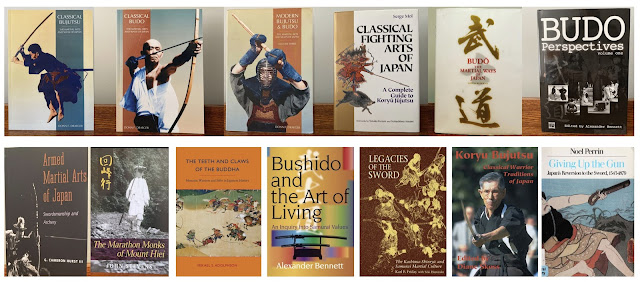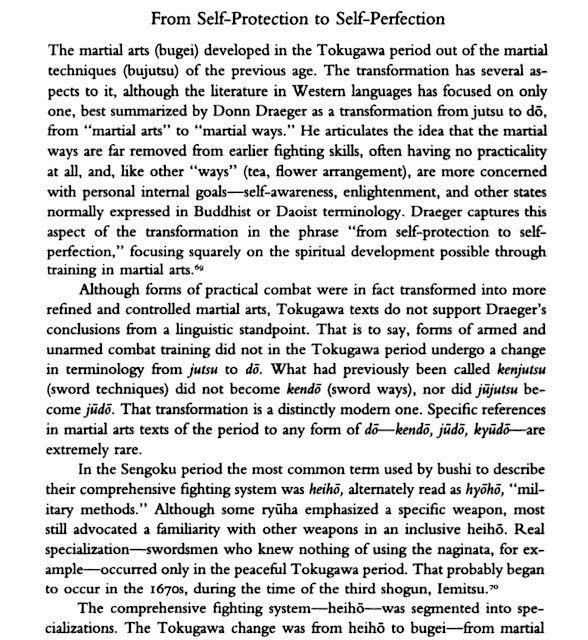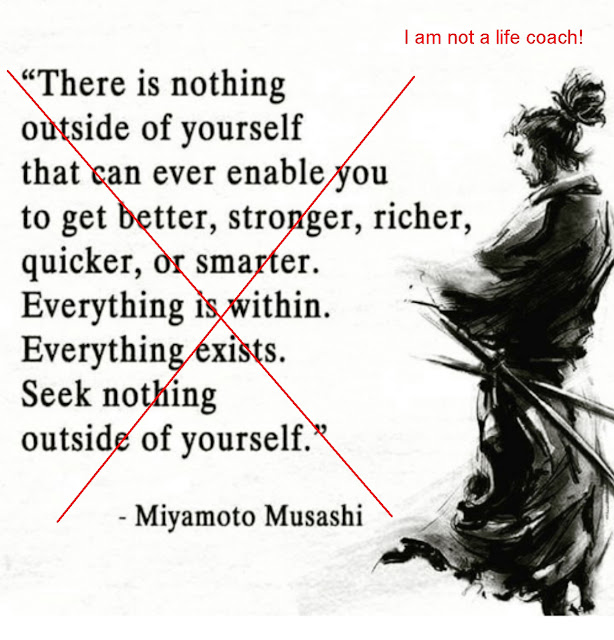June 2021 Book Survey: Budo and Associated Topics Part 1
My (Richard's) reading theme for June 2021 was books on budo and associated topics.
Introduction
I have other books on budo that I did not include in this group, and some of the books may not strictly fit someone else's definition. Nevertheless, what follows are my thoughts on 13 (and maybe more) titles related to Japanese martial arts.
Classical Bujutsu, Classical Budo, and Modern Bujutsu and Budo by Donn F. Draeger, 1973, 1973, 1974
 |
| Classial Bujutsu, Classical Budo, and Modern Bujutsu and Budo, Donn F. Draeger, 1973, 1973, 1974 |
Classical Bujutsu, Classical Budo, and Modern Bujutsu and Budo are three books that deserve the "not bad for the early 1970s, but avoid now" award, along with Secrets of the Samurai by Oscar Ratti and Adele Westbrook, addressed in Survey of Books on Japan's Samurai, Zen, and War.
The first two "Classical" titles are still in print at reasonable prices, probably because they are not as insulting as the third title. All three books lack sources, yet are critical of other martial arts disciplines. Some of the content makes no sense, such as illustrations of Japanese torture techniques in chapters 1 and 2 of the second title, within a discussion of Dō (道). Mr. Draeger describes modern arts in his third title as "perverted practices" (p 64) and "little of lasting value" (p 179). I got the sense that the publisher wanted to forget this third book existed, as it has been out of print since 1996 and is only available at inflated prices on the secondary market.
These three books are the source of the now discredited idea that discussions of Japanese arts progressed linguistically from "jitsu" (術) to "dō". Within about 20 years it was clear that Mr Draeger's assessment was not the case, as the idea of dō had existed since what we consider "martial arts" began developing in Japan in the 15th and 16th centuries. (See the note by Mr Ellis Amdur later in this post for a gentle rebuke of this concept.)
I do not recommend buying these books, unless one wants to see how much progress has been made in serious martial arts writing since the early 1970s. The first two should be combined into a single book anyway, as each is fairly short.
Classical Fighting Arts of Japan: A Complete Guide to Koryu Jujutsu by Serge Mol, 2001
 |
Classical Fighting Arts of Japan: A Complete Guide to Koryu Jujutsu by Serge Mol, 2001 |
Mr. Mol offers insights which help clarify the nature and history of various arts. For example, on p 83 he states "Two jujutsu schools that have been maintained within the same family through the present day are the Takenouchi Ryu (now being continued along two branches of the Takenouch family, with one head referred to as the sodenke and the other as soke), and the Sekiguchi Ryu (Sekiguchi Shinsin Ryu). Other schools may have started out as hereditary, but were passed on to non-family members. One example is the Tenjin Shinyo Ryu, which still exists today."
I have read elsewhere that during the Edo period (1603-1867) lords offered financial incentives for their samurai to study as many specialized martial arts as possible. On p 89 Mr. Mol provides specifics for a practice in the Zeze domain during the Bunka period (January 1804 – April 1818):
 |
| Classical Fighting Arts of Japan, p 89 |
Here we see why instructors would want to open schools, and why samurai would want to receive as many different ranks as possible.
Mr. Mol chooses to roughly group his analysis into three buckets, addressing the Takenouchi Ryu, Fukuno Ryu, and Yoshi Ryu (of Akiyama).
I was not surprised to see Mr. Mol dismiss the notion that Chin Genpin was somehow responsible for jujutsu. I include pages 125 and 126 here to capture his argument for future reference:
 |
 |
| Classical Fighting Arts of Japan, pp 125, 126 |
After a discussion of Kito Ryu on pages 127-129, Mr. Mol includes this fascinating bit of history on the use of the word "judo" prior to Kano Jigoro's application in 1882.
 |
| Classical Fighting Arts of Japan, p 129 |
Overall I thought this book was excellent. The only drawbacks are 1) that it is out of print and hence expensive on the secondary market, and 2) that I cannot personally validate the material, as I do not have access to the Japanese sources and I do not read or speak the language. Nevertheless, if you can find a copy for your library, I believe you will enjoy it.
Armed Martial Arts of Japan by G. Cameron Hurst III, 1998
 |
Armed Martial Arts of Japan by G. Cameron Hurst III, 1998 |
Armed Martial Arts of Japan is one of those rare martial arts books that is heavily cited, well-resourced, well-written, authoritative, and still in print. The late Dr. Hurst based his writings on Japanese primary sources, leveraging his expertise with language and culture.
Accordingly, I enjoyed reading his perspectives on "jitsu" to "dō". His argument is that the Tokugawa period did not see a transition from "jitsu" to "dō," but from bujutsu or heiho to bugei, i.e., martial technique to martial art. In other words, "budo" as a concept was a Meiji phenomenon. The following excerpts capture some of his sentiments.
 |
| Armed Martial Arts of Japan, pp 9,11,12, 202 (endnote) |
Dr. Hurst expands on the transition in chapter 3:
 |
| Armed Martial Arts of Japan, pp 77-79 |
I found this quote on p 72 helped explain the explosion of martial arts schools in the 17th century:
"With the advent of peace [in the Tokugawa era] and the disassociation of warriors from actual combat, formalized instruction in the techniques of fighting -- not only with the sword but also with the spear, the bow, and the rest -- became more common. Earlier warriors were more often too involved in actual combat to teach, so instruction was highly personal, eclectic, and irregular."
I definitely recommend reading this book. It has thankfully had a big impact on subsequent scholarly martial arts texts, with reason.
Budo Perspectives, edited by Dr. Alexander C. Bennett, 2005
 |
Budo Perspectives, edited by Dr. Alexander C. Bennett, 2005 |
Budo Perspectives fits in the "created by Dr. Alexander C. Bennett, so I'm probably going to buy it" category. I've featured his works several times in this blog. This book is a compilation of the papers associated with a November 2003 symposium on budo, designed to stimulate discussion between different budo arts.
The introduction features the "Budo Charter" formulated by the Japanese Budo Association (Nippon Budo Kyogikai 日本武道協議会), an organization which consists of 9 art-specific federations and one other organization, namely:
- Zen Nihon Judo Renmei (All Japan Judo Federation)
- Zen Nippon Kendo Renmei (All Japan Kendo Federation)
- Zen Nihon Kyudo Renmei (All Nippon Kyudo Federation)
- Nihon Sumo Renmei (Japan Sumo Federation)
- Zen Nihon Karatedo Renmei (Japan Karatedo Federation)
- Aikikai (Aikikai [Aikido] Foundation)
- Shorinji Kempo Renmei (Shorinji Kempo Federation)
- Zen Nihon Naginata Renmei (All Japan Naginata Federation)
- Zen Nihon Jukendo Renmei (All Japan Jukendo Federation)
- Nippon Budokan (Nippon Budokan Foundation)
We will hear from this group again in the next book.
Several of the papers stood out for me. First, I enjoyed the essay by top Miyamoto Musashi researcher Uozomi Takashi. Second, Dr. Karl Friday's essay "Off the Warpath: Military Science & Budo in the Evolution of Ryuha Bugei" argues that ryuha bugei (or bugei ryuha -- he switches the order arbitrarily, as far as I can tell) did not develop to teach battlefield martial skills. Rather, their focus was self-improvement from the start.
"The first true bugei ryuha appeared around the turn of the 16th century... ryuha bugei was an abstraction of military science, not merely an application of it... [T]he arts from which they (late Tokugawa bugei] grew were never dirrectly appropriate to battle." There was a "boundary between martial art and military drill" because of "how ill-suited ryuha bugei was to Sengoku [1467-1568] era warfare." "Ryuha bugei was, from its very inception, something closely akin to what we now call budo."
These assertions seem to fly in the face of those who label Japanese martial arts, especially the koryu, as "battlefield arts."
I was pleased to find what appears to be a stand-alone copy of this paper here. It is well worth your time. The book itself is still in print, via print on demand in paperback or hardcopy. I bought the hard copy and have no regrets.
Bushido and the Art of Living by Alexander C. Bennett, 2017
 |
Bushido and the Art of Living by Alexander C. Bennett, 2017 |
Bushido and the Art of Living is the second book in this survey by Dr. Bennett. It's a 2017 translation of his 2013 book, published in Japanese. It's well-written, engaging, straight-forward, and perfect from westerners and martial arts practitioners. It dispels myths of bushido promoted by more famous books, primarily by examining notable Japanese historical texts.
For example, chapter 1 discusses zanshin, or "awareness." Chapter 2 offers lessons from the Koyo-gunkan (c. 1621), compiled by Obata Kagenori and attributed to Kosaka Danjo Masanobu (1527-1578). Chapter 3 discusses the Hagakure by Yamamoto Jocho (1659-1719) and Tashiro Tsuramoto, and Budo-shoshinshu (c. 1725) by Daidoji Yuzan (1639-1730). Chapter 4 features material from the Heiho-kadensho by Yagyu Munenori (1571-1646). The book concludes with personal reflections in chapter 5. I recommend this book as it is in print in physical and digital formats at reasonable prices.
Budo: The Martial Ways of Japan by Nippon Budokan [Foundation], translated by Alexander C. Bennett, 2009
 |
Budo: The Martial Ways of Japan by Nippon Budokan [Foundation], translated by Alexander C. Bennett, 2009 |
The heart of the book are sections on the 9 arts (listed 1-9 in the previous section). This title is nicely put together, with beautiful color photographs, but it also featured weaknesses like mentions of discredited ideas on Zen from Eugene Herrigel (p 10) or "Chuen Yuan-Pin" (aka Chin Gempin).
The Marathon Monks of Mount Hiei by John Stevens, 1988, 2013
 |
| The Marathon Monks of Mount Hiei by John Stevens, 1988, 2013 |
The Marathon Monks of Mount Hiei is a short but enjoyable read. I bought the paperback edition, which is still in print via print on demand. The book is an engaging mix of history, theology, and biography of the monks on Japan's Mount Hiei. If you want a look inside the lives of these fascinating individuals, please consider this book.
The Teeth and Claws of the Buddha: Monastic Warriors and Sohei in Japanese History by Mikael S. Adolphson, 2007
 |
| The Teeth and Claws of the Buddha: Monastic Warriors and Sohei in Japanese History by Mikael S. Adolphson, 2007 |
The Teeth and Claws of the Buddha by Dr. Adolphson is a highly detailed and original work on Japan's so-called "warrior monks." This is a contrarian work that takes shots at lots of other writing, such as books by Stephen Turnbull. Given that Dr. Adolphson bases his conclusions on primary sources in the Japanese language, he has plenty of authority. It appears that the sohei, at least in the popular conception of the last few centuries, are about as real as the ninja, another invented tradition.
This book is in print, in physical and Kindle editions, all at reasonable prices.
Legacies of the Sword: The Kashima-Shinryu and Samurai Martial Culture by Karl F. Friday, 1997
 | ||
| Legacies of the Sword: The Kashima-Shinryu and Samurai Martial Culture by Karl F. Friday, 1997 |
Legacies of the Sword is a book similar to those by Drs. Hurst and Adolphson. The goal of the book, in Dr. Friday's terms, is to learn the physiology of traditional Japanese martial arts (e.g., koryu) by studying the anatomy of a specific art, namely Kashima-Shinryu. The "philosophy and science of combat" chapter (3) reminded me of the approach taken by books by Bruce Lee and Ed Parker Sr. This book, similar to Dr. Hurst's, is well-written, referenced, and sourced, and it belongs in a serious researchers library. It appears to still be in print.
Giving Up the Gun: Japan's Reversion to the Sword, 1543-1879 by Noel Perrin, 1979
 |
| Giving Up the Gun: Japan's Reversion to the Sword, 1543-1879 by Noel Perrin, 1979 |
Giving Up the Gun is a short book and a fast read. It basically describes Japan's history with firearms prior to 1879. I enjoyed the comparisons with western countries like England and France, although I dispute some of the health claims noted by the author for the late 19th century. This book is well-written and organized, with footnotes and endnotes and a huge bibliography. I also enjoyed the many black and white contemporary illustrations. The book is out of print but available on the secondary market and via libraries.
 |
| Koryu Bujutsu: Classical Warrior Traditions of Japan by Diane Skoss, 1997 |
Koryu Bujutsu is a collection of essays, edited by Diane Skoss. This is the first in a series of three, but I only read the first. My favorite aspects of the book were the essays by Mr. Ellis Amdur and Dr. David Hall. As mentioned earlier in this post, Mr. Amdur gently pushes against Mr. Drager's "jitsu" to "dō" thesis. This book is available in print and digital editions, but I recommend checking the table of contents to see if any of the material catches your attention before buying it.
Bonus: Two More Titles!
Before finishing, I'd like to include two other books that I read. These are both basically impossible to find. I could only read copies by borrowing through inter-library loan.
An Introduction to Kodokan Judo: History and Philosophy by David Matsumoto, 1996
 | ||
| An Introduction to Kodokan Judo: History and Philosophy by David Matsumoto, 1996 |
I'd seen several books reference An Introduction to Kodokan Judo by Dr. Matsumoto, so it became one of those "Holy Grail" titles that I sought to find. This would be a neat book to recommend to those searching for the spirit of judo, if only the book were in print. It's impossible to locate on the secondary market, and when it does appear the price is often hundreds of dollars.
I liked the notes on shugyo on p 15. The Chinese characters integrate "mastering correct behaviors" and "making your behavior dignified." The English word "training" lacks the "meaning of moral training" inherent in shugyo. I laughed when I read on page 125 that judokas should not wash their belts, as this is an old school view in many jiu-jitsu gyms as well. On a related note, the author wrote on page 117 that judogi are initially off white in color, but through use they fade to become more white.
Classical Swordsmanship of Japan by Serge Mol, 2010
 | ||
| Classical Swordsmanship of Japan by Serge Mol, 2010 |
Classical Swordsmanship of Japan is also impossible to find, and the author does not respond to messages left on his Eibusha web site, which claims to sell the book. This title is self-published and lacks the editing and copyproofing found in his works released through Kodansha. The English is rough in places, and the author does not understand how to use commas in sentences. For example, on page 17 he states "The saya, is an essential element of sword mounting..." Too many pages feature "walls of unbroken text" and he needs to add more dates when mentioning historical names.
Nevertheless, the book offers excellent figures, art, and illustrations, many from the author's personal collection. There are also great original photographs.
Conclusion
If I had to pick one book to recommend from this list, it would be Dr. Hurst's Armed Martial Arts of Japan. Its primary drawback is that it is only really available as a paperback. For a book of this sort, I prefer a digital copy that I can annotate.
My second choice would be Dr. Bennett's Bushido and the Art of Living. You could download it to your Kindle the moment you finish this post, and begin enjoying it.
For next month's reading, I'm probably returning to Japan to look at more books on the development of budo.
If you like this article, check out our Facebook page, Instagram account, Twitter feed, and Amazon Wish List. Be devoted!











Comments
Post a Comment